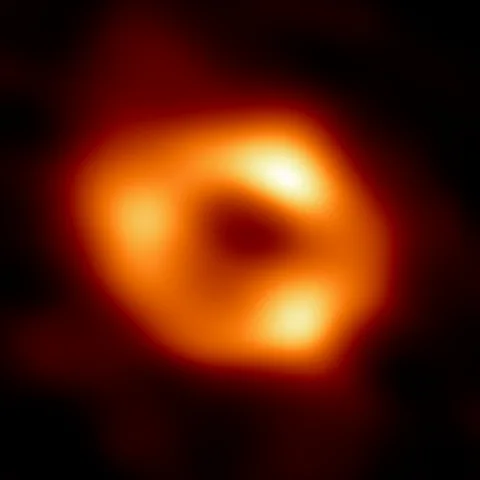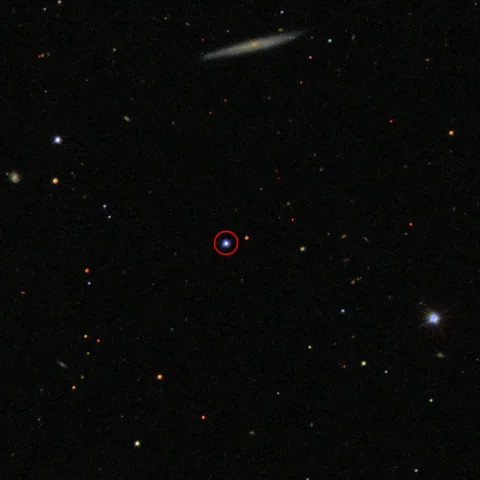Astronomers are spotting a new class of giant black holes that dwarf even the supermassive ones found at the centre of galaxies. Could there be some even more monstrous lurking out there in the darkness of space?
At the centre of our galaxy lives a gargantuan black hole. It is as wide as our Sun but millions of times heavier. Its immense gravitational pull churns the interstellar dust and gas around it. This supermassive black hole is the beating heart of the Milky Way, driving the formation and evolution of our galaxy for its entire 13 billion-year-history, helping to give rise to solar systems like our own. Occasionally, a star wanders too close and is ripped apart, blinking out without a trace of prior existence. It is a terrifying beast, with the power to create and destroy on an epic scale.
Almost every large galaxy has a supermassive black hole at its centre, but in the grand scheme of the Universe, ours – called Sagittarius A* – is a veritable featherweight. Over the past decade, astronomers have discovered black holes much, much larger, known as ultramassive black holes. Some are 1,000 times more massive than Sagittarius A* and large enough to span the entire width of our solar system.
The unparalleled view offered by the James Webb Space Telescope (JWST) is also giving us a new insight into how these behemoths grew at the dawn of time. But there are just as many mysteries – where did they come from, and how big can they really get?
Measuring the size of such enormous and distant objects (which by their very definition cannot be directly observed) is tricky, but we do know some of the largest are astonishingly big. One of the grandest candidates to be discovered to date, known as Ton 618, is found skulking at the middle of a quasar some 18 billion light years from Earth. It is estimated to be 66 billion times the mass of the Sun and is up to 40 times wider than the distance between Neptune and our Sun. The black hole at the centre of a cluster galaxy called Holm 15A was also recently estimated to be around 44 billion times heavier than the Sun, 30 times the Neptune-Sun distance
These are undeniably huge. But some scientists think there could be even larger monsters lurking out there.
"From a theoretical perspective, there's no limit," says James Nightingale, an observational cosmologist at Newcastle University in the UK, who in March 2023 discovered an ultramassive black hole that weighed in at 33 billion times the mass of the Sun.
The black holes we know of come in a range of sizes. At their smallest, micro black holes may range down to the size of an atom. Perhaps more familiar are stellar mass black holes, the result of very massive stars collapsing. These range from about three to 50 times the mass of our Sun, but are condensed into an object "about the size of London", says Julie Hlavacek-Larrondo, an astrophysicist at the University of Montreal in Canada. Intermediate mass black holes form the next group and reach up to about 50,000 times the mass of our Sun, spanning a region of space about the size of the planet Jupiter. Supermassive black holes then stretch up to be millions or billions of times the mass of our Sun.
 EHT Collaboration
EHT CollaborationWhile there is no strict definition of an ultramassive black hole yet, it's generally agreed they begin at "10 billion times the mass of the Sun", says Hlavacek-Larrondo. While in principle there's no reason a black hole can't grow to that size, their existence is unexpected given how we currently understand black holes to grow and the relatively young age of the Universe of just 13.7 billion years.
"It's difficult to build such a massive black hole using traditional methods of feeding," says Hlavacek-Larrondo, referring to how black holes ingest material from around them due to their gravitational pull. "I don't think people expected them to [exist]."
If you keep feeding a black hole, in principle it should just keep growing and growing indefinitely, with any object or material that crosses the event horizon causing the black hole to grow in mass.
In practice, the age of the Universe and the rate at which we think black holes grow should limit their size. Theoretically, if you kept feeding a blacdk hole from the dawn of time, it could have reached 270 billion solar masses by today – but black holes are also not thought to grow consistently, which is why ultramassive black holes are unexpected. Some scientists, however, think it's possible some black holes could have grown much larger, reaching trillions of solar masses in the modern Universe, if they were able to eat material faster than expected. These objects, given the label stupendously large black holes, would have a radius roughly a light-year across. No such objects have yet been found, but we cannot yet rule them out hiding at the centres of some galaxies.
Astronomers spotted the first ultramassive black holes in the early 2010s. Since then, about 100 have been found, including the one found by Nightingale and his colleagues in 2023. They were only able to see it due to the way light from a more distant galaxy was bent around the black hole. "This was a very serendipitous discovery," says Nightingale.
Black holes can also produce hot rings of matter that swirl around them, called accretion disks, as they consume material. The material rotates rapidly around the black hole, with the immense gravity causing it to spiral "at about the speed of light", says Hlavacek-Larrondo. As it falls towards the black hole, the disk of material also emits bright X-rays. The bigger the black hole, the more X-rays and radio waves are produced by the accretion disk and jet respectively.
The physics between ultramassive and smaller black holes is largely the same – fall beyond the event horizon and there is no escape. A larger mass leads to a larger radius for the event horizon. But ultramassive black holes do have an interesting property due to their size.
If you were unfortunate enough to fall into a stellar mass black hole, you would experience something known as spaghettification – your body would be stretched to infinity – because of the difference in gravity between your feet and your head. In an ultramassive black hole, however, the gravitational gradient is much less steep because of it extends so much further out into space, to the point that you'd barely notice falling beyond the event horizon. "Spaghettification would not occur," says Nightingale. The only thing that would betray your fate would be the warping of starlight around you due to the black hole's gravity.
Scientists have discovered hundreds of strange, compact galaxies, which shine far more brightly than might be expected, that existed around 600 million years to one billion years after the Big Bang. They have become known as little red dot galaxies due to their colour and size. What is particularly surprising about them is the light they emit, which seems to indicate supermassive black holes are already lurking within them.
Those observations suggest black holes did indeed grow quickly. In our local universe, the large black holes at the centres of galaxies tend to be about 1,000 times smaller than their host galaxy. But JWST is finding black holes that are the same size as their own galaxy right at the dawn of the Universe, suggesting that black holes may have formed first before galaxies grew around them.
Compared to the local universe, these masses are "tens to a few hundred" times larger than we would expect, says Hannah Übler, a cosmologist at the University of Cambridge in the UK. Astronomers refer to these early titans as "overmassive black holes". It is "really surprising and really puts a challenge to theoretical models to explain how these black holes managed to grow so massive so quickly", says Übler, who has used JWST to observe these early black holes.
 Sloan Digital Sky Survey
Sloan Digital Sky SurveyHow these black holes grew so quickly is a bit of a mystery, and likely relates to how black holes predominantly formed in the early universe. One idea is that they formed from the death of the first stars in the universe, so-called Population III stars – monsters that were 100 to 1,000 times the mass of our Sun and were made almost entirely of helium and hydrogen. The supernovae – a colossal stellar explosion – of these stars in the final stages of their life released heavier elements into the Universe. These would later give rise to other stars and eventually planets, including our Sun and Earth. But their deaths could also have produced large black holes as material collapsed inwards under gravity.
"The black holes from these stars are more massive than stellar mass black holes," says Mar Mezcua, an astrophysicist at the Institute of Space Sciences in Spain. "From this, you can grow and have more chance to become supermassive in a short time."
Another favoured possibility is that the first black holes predominantly formed not from stars but from clouds of gas, known as direct collapse black holes. Usually, these clouds would have formed stars as they condensed under gravity, but if the temperature was high enough, some clouds might not have formed stars but collapsed directly into black holes instead. "These are conditions we do not find in the current universe," says Mezcua. In the hot, tumultuous conditions of the early Universe, however, it may have been possible, she says.
No Population III stars or direct collapse black holes have been definitively seen yet, so it's unclear which mechanism – if either – dominated black hole formation in the early Universe.
 Nasa
NasaHowever those black holes formed, they must have developed a way to grow to large sizes fairly quickly. One possibility is that they were created in abundance and merged together to form bigger and bigger black holes, first intermediate mass, then supermassive, and then for some, ultramassive. This would support the idea they originated from Population III stars, because there would have been more of these than direct collapse black holes so more mergers would have taken place. "If we find today many intermediate black holes, this would mean they form via Population III mechanisms," says Mezcua. If astronomers find a few intermediate mass black holes, in places like smaller dwarf galaxies where they might be expected to arise, it could support the direct collapse black hole idea, says Mezcua.
Ultramassive black holes might also have grown quickly by rapidly consuming material in bursts, something JWST has seen evidence for. Astronomers have observed some early galaxies that are bright and active, but others with a large black hole that appears to be dormant, suggesting the latter must already have eaten lots of material before falling into a slumber. "We don't know how long the cycle would last for," says Hlavacek-Larrondo. Periods of rapid consumption, however, are likely to be rare, she says. "Maybe 1% of the lifetime of the black hole."
What remains unclear is exactly how large black holes might be in the modern cosmos. "We have this rough estimate based on the age of the Universe," says Hlavacek-Larrondo, of around 270 billion solar masses. "But maybe the Universe will surprise us."
--
If you liked this story, sign up for The Essential List newsletter – a handpicked selection of features, videos and can't-miss news, delivered to your inbox twice a week.


Post a Comment